We can enhance our Environmental Impact Assessments (EIA) for wind energy by following ten essential tips. First, we should engage stakeholders early to address concerns and incorporate local insights. Thorough baseline studies must be conducted, utilizing methods like eDNA analysis and GIS for accurate data on flora, fauna, and water quality. Evaluating visual impacts is vital, as is examining biodiversity effects through species inventories and habitat monitoring. Additionally, we need to analyze water resource impacts, develop mitigation strategies, guarantee compliance with regulations, incorporate climate change resilience, and foster interagency collaboration for more effective outcomes. By adhering to these principles, we can achieve balanced results.
Key Takeaways
- Engage local stakeholders early to address concerns and gather diverse inputs for more effective Environmental Impact Assessments (EIA).
- Conduct comprehensive baseline studies to establish current environmental conditions, identifying sensitive species and habitats before project initiation.
- Utilize advanced methods like eDNA analysis and GIS technology for accurate biodiversity assessments and to monitor habitat changes over time.
- Implement robust air and water quality monitoring plans to ensure compliance with regulatory standards and address community concerns regarding resource availability.
- Develop targeted mitigation strategies, including habitat restoration and operational curtailment during peak wildlife activity, to minimize adverse impacts on the environment.
Engage Stakeholders Early
Engaging stakeholders early in the wind energy project planning process is essential for addressing potential concerns and building trust within the community. Through early stakeholder engagement, we can identify and articulate the views of local communities, ensuring that their knowledge informs the Environmental Impact Assessments (EIA). This proactive approach, supported by Article 5 of the World Heritage Convention, emphasizes meaningful participation, which can enhance project outcomes and foster public support. By employing tools like surveys and public workshops, we can capture diverse inputs, leading to effective mitigation strategies. Research indicates that projects with robust stakeholder involvement experience fewer conflicts and delays, ultimately resulting in smoother implementation and better compliance with regulations, which is crucial for our collective freedom and environmental stewardship.
Conduct Comprehensive Baseline Studies

To effectively assess the potential environmental impacts of wind energy projects, we must conduct extensive baseline studies that provide critical data on current ecological conditions, including flora, fauna, soil, water quality, and air quality. By employing various data collection methods such as field surveys, remote sensing, and environmental DNA (eDNA) analysis, we can capture a holistic view of biodiversity and ecosystem dynamics within the project area. This foundational information not only informs our impact predictions and mitigation strategies but also addresses the concerns of local communities and stakeholders, ensuring a thorough and transparent environmental impact assessment process.
Importance of Baseline Data
Thorough baseline studies are vital for understanding existing environmental conditions, and they often form the foundation of effective decision-making in wind energy projects. By collecting baseline data, we can accurately assess local flora and fauna, air and water quality, and socio-economic factors, creating a detailed view of the environment prior to development. This data is essential for pinpointing sensitive receptors, such as endangered species and vulnerable communities, allowing us to craft informed mitigation measures that can greatly reduce potential environmental impacts. Furthermore, longitudinal baseline studies enable us to track changes over time, fostering adaptive management as projects evolve. Ultimately, robust baseline assessments lead to more transparent Environmental Impact Assessments (EIAs), minimizing uncertainties and filling important knowledge gaps.
Methods for Data Collection
Conducting thorough baseline studies is essential for informing our understanding of the environmental landscape before initiating wind energy projects. We must employ a variety of methods, including eDNA analysis, to assess local biodiversity without direct observation, ensuring a complete ecological survey. Additionally, hydrological assessments are crucial for evaluating the potential impacts on groundwater and surface water quality, identifying any changes early in the process. Socio-economic baseline studies should gather data on community demographics, land use, and economic activities to gauge how the project affects local livelihoods. Moreover, noise and visual impact assessments utilizing GIS technology allow us to map noise-sensitive areas and visual corridors, enabling accurate predictions of disturbances that could affect residents and wildlife alike.
Analyzing Environmental Conditions
Building on the methods we've discussed for data collection, analyzing environmental conditions through thorough baseline studies is fundamental for understanding the impacts of proposed wind energy projects. These extensive baseline studies involve collecting critical data on existing environmental conditions, including flora, fauna, soil quality, and water resources, providing a reference point for evaluating potential impacts. We should conduct habitat evaluations, species inventories, and air and water quality assessments over multiple seasons to capture temporal variations in wildlife activity. Engaging local stakeholders and experts enriches data accuracy, ensuring all relevant factors are considered. The information gathered is essential for predicting potential impacts, developing effective mitigation strategies, and ensuring compliance with regulatory requirements, ultimately promoting sustainable wind energy project development.
Assess Visual and Landscape Impacts

Evaluating visual and landscape impacts is an important step in the planning of wind energy projects. We conduct visual impact assessments utilizing GIS technology to perform viewshed analyses, quantifying the number and percentage of wind turbines visible from various locations within nearby communities. Additionally, we employ photo simulation techniques to create realistic visual representations, allowing stakeholders to visualize changes to the landscape. It's vital to evaluate potential shadow flicker effects by calculating the expected hours of shadow cast on nearby residences, which informs our mitigation strategies. Engaging local stakeholders during this phase fosters community acceptance, addressing aesthetic concerns and regulatory requirements. Ultimately, a thorough assessment guarantees that our wind farms integrate seamlessly into the existing environment, balancing energy needs with community values.
Evaluate Biodiversity Effects
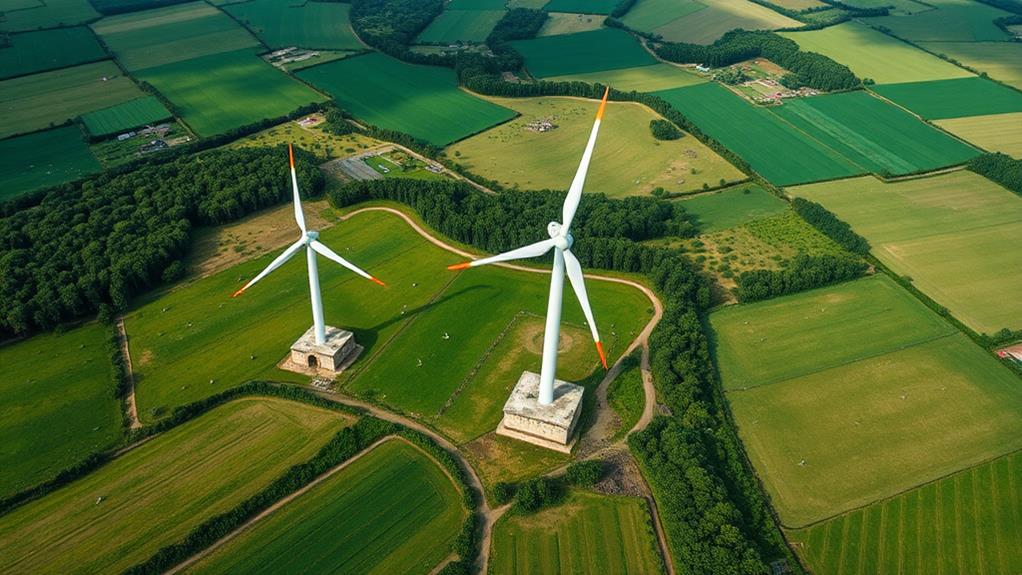
As we assess the biodiversity effects of wind energy projects, it's essential to evaluate species presence through thorough baseline studies and continuous monitoring of habitat changes. By implementing targeted mitigation strategies, such as curtailment during vital wildlife activity periods, we can greatly minimize the potential impact on sensitive species and their habitats. Engaging with local communities, we can incorporate traditional knowledge into our assessments, ensuring a holistic approach to biodiversity conservation throughout the project lifecycle.
Assess Species Presence
To effectively assess species presence in areas impacted by wind energy projects, we must employ a range of innovative techniques that capture a thorough picture of local biodiversity. Utilizing environmental DNA (eDNA) analysis offers a non-invasive method for collecting genetic material from environmental samples, enhancing our species detection capabilities. Baseline studies should include assessments of key species and habitats, documenting sensitive or endangered species potentially affected by wind turbine installations. Advanced monitoring technologies like thermal imaging and acoustic sensors facilitate accurate evaluations of wildlife presence and behavior in relation to turbine activity. Collaboration with wildlife biologists during the scoping phase is essential for identifying potential environmental impacts early on.
| Technique | Purpose |
|---|---|
| eDNA Analysis | Non-invasive species detection |
| Thermal Imaging | Assess wildlife presence |
| Acoustic Sensors | Monitor behavior related to turbines |
| Baseline Studies | Identify key species and habitats |
Monitor Habitat Changes
Monitoring habitat changes is essential for understanding the effects of wind energy projects on local biodiversity. By employing environmental DNA (eDNA) analysis, we can non-invasively monitor species presence without directly disturbing habitats, which is critical for minimizing impacts. Conducting baseline studies prior to development establishes a reference point for evaluating biodiversity and habitat alterations. Continuous monitoring, especially of sensitive species, allows us to capture the cumulative impacts of installations on local ecosystems. Additionally, post-construction monitoring programs provide insights into wildlife habitat use, enabling us to adapt management practices effectively. Collaborating with local conservation organizations enhances our biodiversity evaluations, ensuring our monitoring efforts remain relevant and informed, ultimately promoting a more sustainable relationship between wind energy projects and the environment.
Implement Mitigation Strategies
Frequently evaluating biodiversity effects is crucial when implementing mitigation strategies for wind energy projects. We should commence with thorough baseline studies to assess existing biodiversity, pinpointing sensitive species and habitats at risk from wind energy farms. Utilizing non-invasive eDNA analysis can greatly enhance our biodiversity assessments, guaranteeing compliance with Environmental Impact Assessment standards. Additionally, adopting curtailment strategies during peak wildlife activity periods is essential to minimize collision risks for avian and bat populations, as research from the Wind Energy Technologies Office indicates. Developing habitat management plans tailored to protect critical species is equally important, alongside regular post-construction monitoring and reporting on biodiversity impacts to adaptively manage our projects. This approach not only guarantees compliance but also fosters better conservation outcomes.
Analyze Water Resource Impacts
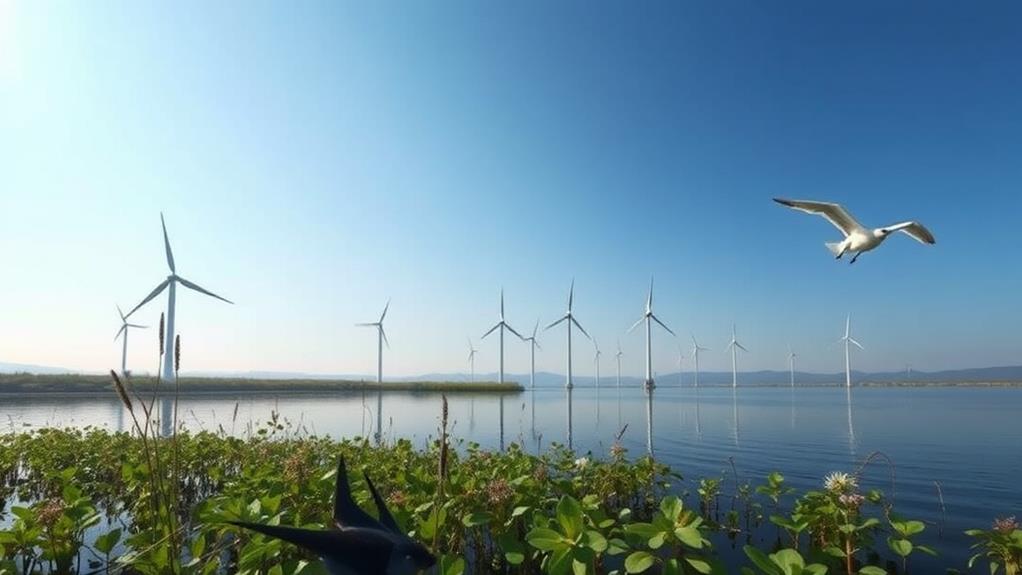
When evaluating the environmental impacts of wind energy projects, analyzing water resource implications is essential. We must thoroughly assess how our activities might alter local hydrology, including potential changes in surface and groundwater levels. To effectively evaluate these impacts, we should consider the following:
- Conduct baseline studies to establish existing water conditions.
- Identify potential sedimentation and runoff risks during construction.
- Engage with local communities to address concerns about water availability and quality.
- Develop robust monitoring plans to guarantee compliance with water quality standards.
Monitor Air Quality Changes
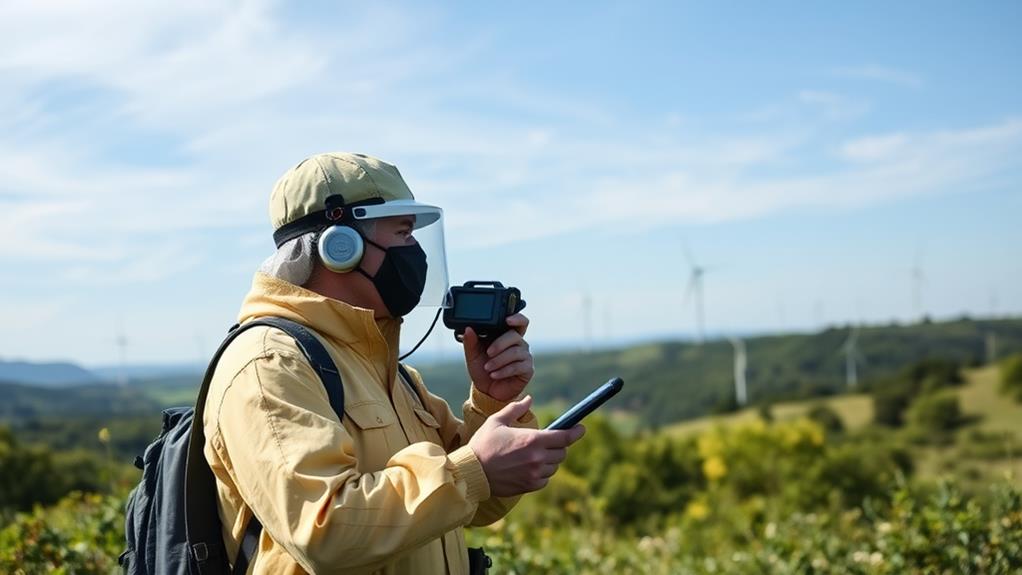
As we assess the environmental impact of wind energy projects, monitoring air quality changes becomes essential for understanding the implications of construction and turbine operation on local air pollutants. Establishing a baseline air quality assessment prior to construction allows us to accurately measure deviations in particulate matter and volatile organic compounds, while implementing continuous monitoring techniques guarantees we can respond swiftly to any significant changes observed during both construction and operational phases. By prioritizing these strategies, we not only comply with local and federal air quality regulations but also safeguard public health and enhance the overall effectiveness of our wind energy initiatives.
Baseline Air Quality Assessment
Understanding the importance of baseline air quality assessments is essential for evaluating the potential impacts of wind energy projects. These assessments measure existing air quality pollutants like particulate matter (PM), nitrogen oxides (NOx), and sulfur dioxide (SO2), establishing a reference point vital for future evaluations.
To guarantee thorough assessments, we should focus on:
- Seasonal variations in air quality due to environmental factors
- Compliance with regulatory guidelines from the U.S. Environmental Protection Agency (EPA)
- Identification of potential impacts on nearby communities and ecosystems
- Development of effective mitigation strategies for construction and operation phases
Continuous Monitoring Techniques
Continuous air quality monitoring techniques play an important role in evaluating the impacts of wind energy projects. By using real-time sensors, we can immediately detect changes in pollutants like nitrogen oxides (NOx) and particulate matter (PM) resulting from construction and operations. This guarantees we can implement effective mitigation strategies to safeguard local air quality.
| Pollutant Type | Monitoring Strategy |
|---|---|
| NOx | Real-time Sensors |
| PM | Baseline Comparisons |
| VOCs | Continuous Sampling |
| CO2 | Adaptive Management |
| SO2 | Regulatory Compliance |
Establishing baseline air quality data before project implementation is crucial for evaluating potential changes. In addition, collaborating with local environmental agencies enhances monitoring efforts, guaranteeing compliance with regulations and community health protections.
Mitigation Strategies Implementation
Effective mitigation strategies are essential for managing air quality changes during wind energy projects. By implementing robust air quality monitoring systems, we can track emissions and identify significant changes in local ecosystems that may arise from construction and turbine operations. Continuous measurement of pollutants like particulate matter (PM), nitrogen oxides (NOx), and volatile organic compounds (VOCs) is vital for evaluating compliance with air quality standards.
We should focus on:
- Utilizing remote sensing technologies for real-time data
- Comparing air quality evaluations against baseline studies
- Engaging local communities for transparency
- Taking swift action if air quality standards are approached or exceeded
Through diligent monitoring and proactive mitigation strategies, we can protect both human health and the environment throughout the project lifecycle.
Develop Mitigation Strategies

To develop successful mitigation strategies for wind energy projects, we should focus on minimizing adverse impacts on wildlife and their habitats. Implementing measures such as curtailing turbine operations during peak wildlife activity periods, as outlined by the U.S. Fish and Wildlife Service, is essential for reducing environmental impacts. In addition, engaging with local communities and stakeholders during the planning phase fosters collaboration and addresses socio-economic concerns. We can enhance biodiversity preservation through habitat restoration and utilizing technologies like eDNA analysis to accurately identify species in project areas. Additionally, continuous monitoring and adaptive management must be integral to our strategies, ensuring timely adjustments based on observed environmental impacts post-construction, thereby maintaining ecological balance and promoting sustainable development.
Ensure Regulatory Compliance
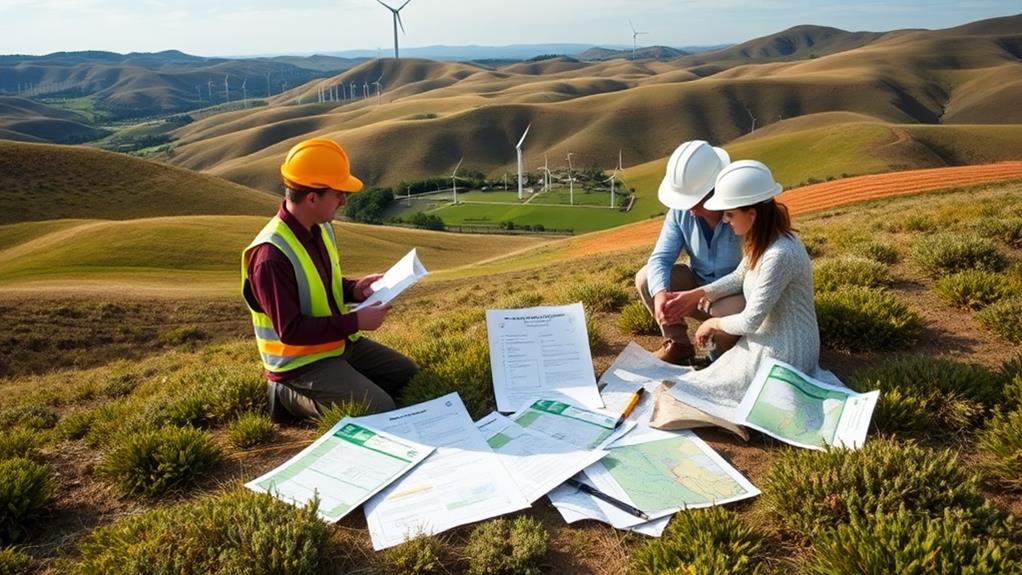
Mitigation strategies must align with regulatory compliance to guarantee wind energy projects are sustainable and legally sound. We must prioritize adherence to local, state, and federal laws, especially the National Environmental Policy Act (NEPA), which necessitates detailed environmental assessments prior to project approvals. To effectively navigate the permitting processes, we should:
- Engage with federal agencies early, like the U.S. Fish and Wildlife Service.
- Conduct baseline environmental studies to assess potential impacts on sensitive habitats and species.
- Implement continuous monitoring and reporting of environmental impacts during and after construction.
- Adopt proactive measures, as non-compliance can lead to fines, delays, and reputational harm, underscoring the importance of a thorough regulatory adherence throughout the project lifecycle.
Incorporate Climate Change Resilience
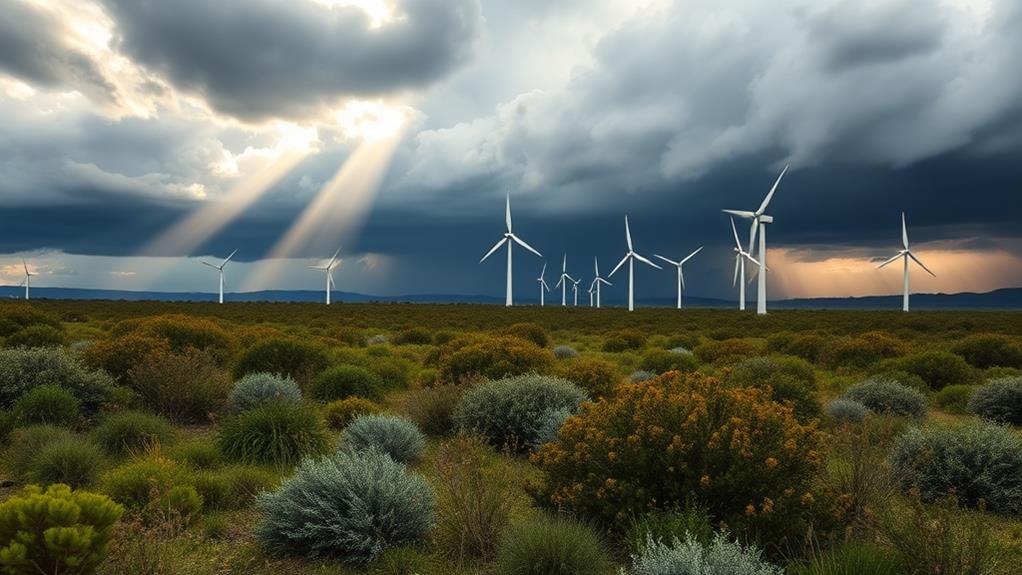
Incorporating climate change resilience into our Environmental Impact Evaluations (EIAs) is essential for the long-term success of wind energy projects. We must evaluate the potential impacts of climate change, including extreme weather events and temperature fluctuations, to guarantee operational efficiency. By integrating climate change scenarios into our EIA process, we can anticipate disruptions in wind energy generation and develop robust mitigation strategies. Additionally, appraising the durability of wind turbine structures against risks like rising sea levels and increased storm intensity enhances the sustainability of our environmentally friendly initiatives. Moreover, analyzing local ecosystems for their adaptability to climate change guarantees we don't exacerbate existing vulnerabilities in flora and fauna, ultimately supporting our commitment to renewable energy and environmental stewardship.
Foster Interagency Collaboration
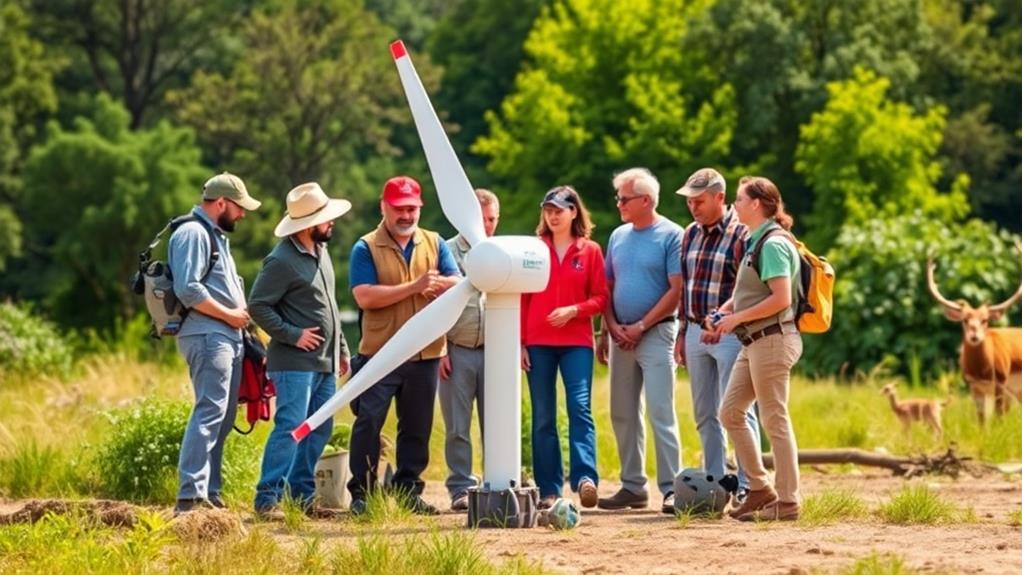
Fostering interagency collaboration is essential for the success of wind energy projects and their environmental assessments. By working together, we can effectively address the complex challenges associated with environmental impacts and wildlife protection. Collaborative efforts among various agencies lead to enhanced regulatory compliance and more robust guidelines. Key benefits of interagency collaboration include:
- Development of wildlife protection guidelines with agencies like the U.S. Fish and Wildlife Service.
- Standardized measurement of wildlife impacts through partnerships with the United States Geological Survey.
- Thorough assessments of environmental impacts facilitated by the Bureau of Ocean Energy Management.
- Sharing of best practices and resources to improve monitoring and mitigation strategies.
Together, these initiatives empower us to make informed decisions that prioritize both energy development and environmental stewardship.
Frequently Asked Questions
What Is the Environmental Impact Assessment for Wind Farms?
When considering wind farms, we must prioritize regulatory frameworks and stakeholder engagement. By focusing on habitat preservation and conducting thorough noise assessments, we can guarantee a balance between energy needs and environmental freedom for all.
What Are the Techniques Used for Wind Resource Assessment?
Like artists painting a landscape, we use measurement tools and modeling techniques for site selection. Through diligent data collection, we uncover the wind's secrets, guiding us toward harnessing its untamed energy for a brighter future.
What Are 2 Environmental Impacts of Wind Power?
When we consider wind power's environmental impacts, we can't ignore bird mortality from collisions, habitat disruption for wildlife, noise pollution affecting communities, and the visual impact on landscapes. Balancing energy needs with nature's freedom is essential.
What Are the Environmental Factors Associated With Wind Energy?
As we journey through the world of wind energy, we must consider biodiversity, noise pollution, land use, and visual impacts. Together, we can balance freedom and sustainability, ensuring a harmonious coexistence with nature.









